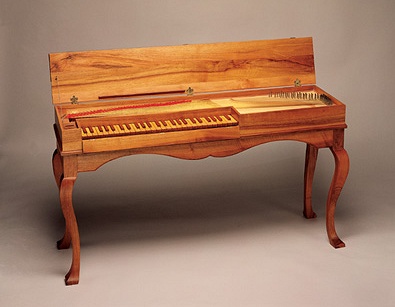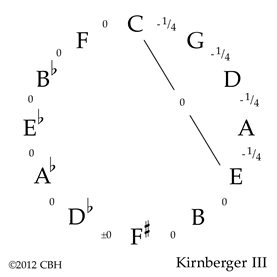Technical Library
TUNING XII: Tuning the Double-fretted Clavichord
Entire Contents Copyright © 2022 CBHTechnical LibraryTUNING XII: Tuning the Double-fretted Clavichord Entire Contents Copyright © 2022 CBH |
The Double-fretted clavichord after Hubert was initially designed by David Jacques Way and Marc Ducornet, and has now been refined and taken over by THE PARIS WORKSHOP. Seeing as I made a page to assist the owners of Triple-fretted instruments, I should not neglect those who own an instrument modeled on later originals.
This model clavichord was originally conceived at Baroque pitch A415, but in fact sounds brighter and works fine using the same stringing schedule at modern pitch A440: You choose.
 THE PARIS WORKSHOP |
| Double-fretted Clavichord after Hubert |
The key levers of this instrument were cranked with a well temperament in mind, and the exact temperament set by the initial maker firstly locating and then bending the tangents to strike the string pairs at the correct point.
A diatonic system like the Hubert model, with all the Ds and As independently strung, means you’ll only need to actually tune the “white” keys in each octave, and the accidentals will come into tune as a result. For example, when you tune middle c', c♯' will come into tune. You must set d' by itself, but e♭' will come into tune when you determine e'. The f♯' comes from the f' and so on.
In practice, though, to accomplish this temperament it will be easier if I actually get you to tune most of the accidentals, pulling the naturals into tune, because all of the “black” notes in Kirnberger III can be determined by pure fifths, no tempering required.
To help you navigate your way around the tuning pins, some like to color the top of all the Cs with a black permanent ink felt marker. You’ll need your tuning hammer—we make a specially elegant one, complete with stringing hook—and a tuning mute so you can silence one string of each pair to avoid confusing your ears. To ensure you return your instrument to the same basic pitch, you’ll also need a pitch source like a tuning fork, a simple electronic tuner, or an app on your phone.
Using the mute requires a little intelligence: Play the note with your left hand, and slide the mute in directly behind the tangent. Now continue from that point, tracing towards the bridge, and leave the mute close to the bridge, allowing its thin tail to rest on the soundboard. The furthest string of the pair is now damped, and you are ready to tune the string closest to you. When you are happy with that, you pull the mute out and bring the unison into tune, adjusting the tension of the string of the pair that is furthest from you.
You can find a full discussion of both Tuning Background and Historic Temperaments in the Technical Library. Here, I’ve revized the tuning directions to take account of your specific instrument, assuming that your instrument is in good condition and the maker has adequately setup the temperament when he built the clavichord.
 One of the easiest—and most practical—temperaments to set dates from
1779 and is known as Kirnberger III. This is a perfect temperament for
your Double-fretted Clavichord, proposed right around the period when Hubert
was active. For a while, some people thought that this might be Bach’s
temperament, seeing as Kirnberger learnt from the great JS himself. Despite what
you might have been taught, Bach neither invented nor used equal temperament.
He probably used many different tuning systems—if he had one particular
one in mind for any of his works, he never chose to write his directions
for setting it. Note that his great opus is called the Well-tempered Clavier, not the “Equal Tempered Clavichord”, as it has too often been
mistranslated.
One of the easiest—and most practical—temperaments to set dates from
1779 and is known as Kirnberger III. This is a perfect temperament for
your Double-fretted Clavichord, proposed right around the period when Hubert
was active. For a while, some people thought that this might be Bach’s
temperament, seeing as Kirnberger learnt from the great JS himself. Despite what
you might have been taught, Bach neither invented nor used equal temperament.
He probably used many different tuning systems—if he had one particular
one in mind for any of his works, he never chose to write his directions
for setting it. Note that his great opus is called the Well-tempered Clavier, not the “Equal Tempered Clavichord”, as it has too often been
mistranslated.
Here’s how you go about tuning your Double-fretted Clavichord in Kirnberger III:
1. We are going to set this temperament from C rather than from A, so tune c'' to your desired pitch source. That’s your c'' above middle c'.
2. If you do most of your tempering in the octave below middle c', you may find it a little easier to hear, so tune a perfect octave down to middle c', and then down another octave to determine c. (By virtue of your double-fretting, your c♯' is in tune without you doing anything, and while you are here, you might as well tune down an octave to determine c♯, because we will need it soon—we must fuss with this detail now, because you are entering the unfretted bass range of the instrument.)
3. Now we want to determine the e' a perfect third above middle c': This will be a revelation if you have never heard a perfect third before—Your violinist friends are going to find it unbearably flat, but we want it in perfect tune. (Hint—if you split your interval over the octave, you will find it easier to hear because the speed of the beats is halved, that’s why I had you tune the tenor c.) Extend this e' a beatless octave down to e, which should also make a perfect third from your c. Also take the opportunity to tune your e♭ with the octave above, just as you did with the c♯.
4. Check the diagram to see what you are trying to accomplish, and observe that all the fifths the long way around the flat side of C to E, are in fact perfect. Let’s tune them one at a time. Tune down a perfect 5th from middle c' to find f. The fifth should be beatless, and because of your double-fretting, so should the fifth a semitone higher, f♯ to c♯', without you doing anything.
5. Take this f up an octave to f'. Tune down another perfect fifth from f' to b♭. Check that it is absolutely pure, and again check your fifth a semitone higher, b to f♯', which should be pure. Your b should also happen to make a perfect fifth with the e below which you’ve already tuned. Also check that your already tuned e♭ makes a perfect fifth with b♭.
6. Tune down another perfect fifth from e♭' to a♭. Check again that it is absolutely pure, and in fact also makes a perfect fifth with your d♭below.
7. In one way, we’ve left the trickiest bit for last. So far, all your intervals have been pure. Now we must determine the narrow fifths, shown on the diagram by the minus sign in front of the quarters. Because you’ve just tuned the a♭, the g has come into tune. Note that we cannot check this as a perfect fifth from the c below, because that fifth is supposed to be deliberately out of tune! If your clavichord was set up correctly to begin, and you’ve done everything right, you should have a fifth that is truly a quarter comma narrow. Generally, it’s about as much out of tune as what you should be able to stand. Tune down an octave from g to G.
9. Let’s try to find the independent a. Tune it first of all a perfect fifth below e', then narrow the fifth by sharpening your a until it is about as coarse as you can stand. Pop down to d, again first of all tuning it a pure fifth to a, and then raising it until you have a definite beat, both with the a, and with your bottom G a fifth below. There’s often a bit of juggling to do at this stage. If you compare your fifth d–a with c–g, the former should beat just slightly faster because of its higher pitch. Likewise, G–d with A–e.
10. When you are happy, just again check that the fifths you mean to be perfect are indeed so, and then you must bring the rest of your instrument into tune with what you have done. Tune down in octaves, working on every note in the bass, but when you are ready to do the treble, remember because of the fretting you really only need to set the naturals, checking the accidentals as you go.
Enjoy!
| Technical Library overview | |
| Harpsichords Australia Home Page |